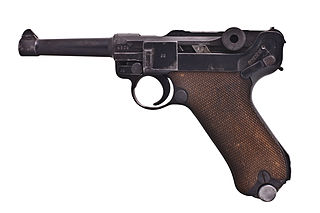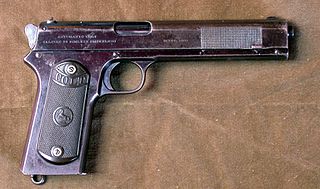Related Research Articles

The Pistole Parabellum or Parabellum-Pistole, commonly known as just the Luger or Luger P08, is a toggle-locked recoil-operated semi-automatic pistol. The Luger was produced in several models and by several nations from 1898 to 1949.

The Thompson submachine gun is a blowback-operated, selective-fire submachine gun, invented by United States Army brigadier general John T. Thompson in 1918. It was originally designed to break the stalemate of trench warfare of World War I, but was not finished until after the war ended.

The M1911 is a single-action, recoil-operated, semi-automatic pistol chambered for the .45 ACP cartridge. The pistol's formal U.S. military designation as of 1940 was Automatic Pistol, Caliber .45, M1911 for the original model adopted in March 1911, and Automatic Pistol, Caliber .45, M1911A1 for the improved M1911A1 model which entered service in 1926. The designation changed to Pistol, Caliber .45, Automatic, M1911A1 in the Vietnam War era.

The Browning Automatic Rifle (BAR) is a family of American automatic rifles and machine guns used by the United States and numerous other countries during the 20th century. The primary variant of the BAR series was the M1918, chambered for the .30-06 Springfield rifle cartridge and designed by John Browning in 1917 for the American Expeditionary Forces in Europe as a replacement for the French-made Chauchat and M1909 Benét–Mercié machine guns that US forces had previously been issued.

The Colt Single Action Army is a single-action revolver handgun. It was designed for the U.S. government service revolver trials of 1872 by Colt's Patent Firearms Manufacturing Company and was adopted as the standard-issued pistol of the U.S. Army from 1873 until 1892.

The .45 ACP or .45 Auto (11.43×23mm) is a rimless straight-walled handgun cartridge designed by John Moses Browning in 1904, for use in his prototype Colt semi-automatic pistol. After successful military trials, it was adopted as the standard chambering for Colt's M1911 pistol. The round was developed due to a lack of stopping power experienced in the Moro Rebellion in places like Sulu. The issued ammunition, .38 Long Colt, had proved inadequate, motivating the search for a better cartridge. This experience and the Thompson–LaGarde Tests of 1904 led the Army and the Cavalry to decide that a minimum of .45 caliber was required in a new handgun cartridge.

The Vis or Vis 35 is a Polish 9×19mm caliber, single-action, semi-automatic pistol. Its design was inspired by the Colt 1911 pistol designed by American John Moses Browning.

The .45 Colt (11.43×33mmR), is a rimmed, straight-walled, handgun cartridge dating to 1872. It was originally a black-powder revolver round developed for the Colt Single Action Army revolver. This cartridge was adopted by the U.S. Army in 1873 and served as an official US military handgun cartridge for 14 years.
The Springfield Model 1873 was the first standard-issue breech-loading rifle adopted by the United States Army. The gun, in both full-length and carbine versions, was widely used in subsequent battles against Native Americans.

The M1917 Revolvers were six-shot, .45 ACP, large frame revolvers adopted by the United States Military in 1917, to supplement the standard M1911 pistol during World War I. There were two variations of the M1917, one made by Colt and the other by Smith & Wesson. They used moon-clips to hold the cartridges in position, facilitate reloading, and to aid in extraction since revolvers had been designed to eject rimmed cartridges and .45 ACP rounds were rimless for use with the magazine-fed M1911. After World War I, they gained a strong following among civilian shooters. A commercial rimmed cartridge, the .45 Auto Rim, was also developed, so M1917 revolvers could eject cartridge cases without using moon-clips.

In American English, a pocket pistol is any small, pocket-sized semi-automatic pistol, and is suitable for concealed carry in a pocket or similar space.

The Colt Model 1900 is a short-recoil operated "self-loading", or semi-automatic .38 caliber handgun introduced by Colt's Manufacturing Company at the turn of the 20th century. It also marked the introduction of .38 ACP, the round for which it is chambered, and was the first handgun to utilize short-recoil operation.

The Model 1902 is a semi-automatic pistol developed by famous American firearms designer John Browning and produced by the Colt's Patent Firearms Manufacturing Company in the early 20th century. The Model 1902 was not a new design, but rather an incremental improvement upon the nearly identical M1900, and would transition from the 1900 into three distinct but related pistols with the same action and cartridge, the 1902 Sporting Model, the 1902 Military model, and the 1903 Pocket Hammer model. The 1902 Sporting model was so similar to the 1900 that it continued the serial number range, while the 1902 Military Model featured a different serial range as did the 1903 Pocket Hammer model. The 1902 Military Model featured a square and lengthened grip frame with an additional round in the magazine, while the 1903 Pocket Hammer featured a shortened barrel and slide but retained the Sporting model grip frame. The Colt M1905 .45 ACP pistol would be derived from the same lineage, also with a different serial number range.

The MEU(SOC) pistol, officially designated the M45 MEUSOC, is a magazine-fed, recoil-operated, single-action, semiautomatic pistol chambered for the .45 ACP cartridge. A variant of the M1911, it has been the standard-issue side arm for the Force Recon Element of the United States Marine Corps' Marine Expeditionary Units since 1985. It is assigned NATO Stock Number 1005-01-370-7353.

Indústria de Material Bélico do Brasil is a Ministry of Defence quango, founded in 1975, which coordinates industrial activity related to the planning and production of war material through the transfer of technology and the financial and technical support of new military development.

The Roth–Steyr M1907, or, more accurately Roth-Krnka M.7 was a semi-automatic pistol issued to the Austro-Hungarian kaiserliche und königliche Armee cavalry during World War I. It was the first adoption of a semi-automatic service pistol by the land army of a major power.

The Springfield Armory EMP is a semi-automatic pistol based on the classic M1911 design and manufactured by Springfield Armory, Inc. Whereas the M1911 uses the .45 ACP cartridge, the EMP uses smaller 9×19mm Parabellum or .40 S&W cartridges. It has been reengineered to make it smaller and lighter than its parent firearm, and is marketed as a "short-action 1911". EMP stands for "Enhanced Micro Pistol". It is similar to the Colt Defender and Para-Ordnance Slim Hawg.
The Colt Model 1910 was a prototype .45 ACP caliber automatic pistol developed by John Browning as an improvement of the earlier Colt Model 1909, which was rejected by the United States Department of War due to the Cavalry's belief that the design was too complicated for use by enlisted men, and because it lacked a safety mechanism. The M1910 was a drastic modification on Browning's part, modifying and adding many features that the M1909 was not equipped with.
References
- ↑ http://www.coltautos.com Archived 2006-01-17 at the Wayback Machine
- ↑ Archived at Ghostarchive and the Wayback Machine : Colt's Model 1909 .45 ACP Pistol. YouTube .

